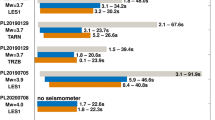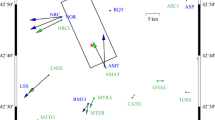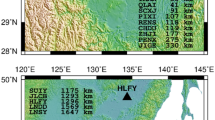Abstract
The developments in GNSS receiver and antenna technologies, especially the increased sampling rate up to 100 sps, open up the possibility to measure high-rate earthquake ground motions with GNSS. In this paper we focus on the GPS errors in the frequency band above 1 Hz. The dominant error sources are mainly the carrier phase jitter caused by thermal noise and the stress error caused by the dynamics, e.g. antenna motions. To generate a large set of different motions, we used a single-axis shake table, where a GNSS antenna and a strong motion seismometer were mounted with a well-known ground truth. The generated motions were recorded with three different GNSS receivers with sampling rates up to 100 sps and different receiver baseband parameters. The baseband parameters directly dictate the carrier phase jitter and the correlations between subsequent epochs. A narrow loop filter bandwidth keeps the carrier phase jitter on a low level, but has an extreme impact on the receiver response for motions above 1 Hz. The amplitudes above 3 Hz are overestimated up to 50 % or reduced by well over half. The corresponding phase errors are between 30 and 90 degrees. Compared to the GNSS receiver response, the strong motion seismometer measurements do not show any amplitude or phase variations for the frequency range from 1 to 20 Hz. Due to the large errors for dynamic GNSS measurements, it is essential to account for the baseband parameters of the GNSS receivers if high-rate GNSS is to become a valuable tool for seismic displacement measurements above 1 Hz. Fortunately, the receiver response can be corrected by an inverse filter if the baseband parameters are known.



















Similar content being viewed by others
References
Avallone A, Marzario M, Cirella A, Piatanesi A, Rovelli A, Di AC, D’Anastasio E, D’Agostino N, Giuliani R, Mattone M (2011) 10 Hz GPS seismology for moderate magnitude earthquakes: the case of the Mw 6.3 L’Aquila (Central Italy) event. J Geophys Res 116:B02305. doi:10.1029/2010JB007834
Bilich AL, Cassidy JF, Larson KM (2008) GPS seismology: application to the 2002 Mw 7.9 Denali fault earthquake. Bull Seismol Soc Am 98(2):593–606. doi:10.1785/0120070096
Bock Y, Prawirodirdjo L, Melbourne TI (2004) Detection of arbitrarily large dynamic ground motions with a dense high-rate GPS network. Geophys Res Lett 31:L06604. doi:10.1029/2003GL019150
Clinton JF (2004) Modern digital seismology: instrumentation, and small amplitude studies in the engineering world. Ph.D. thesis, California Institute of Technology, Pasadena, CA
Curran JT, Lachapelle G, Murphy CC (2012) Digital GNSS PLL design conditioned on thermal and oscillator phase noise. IEEE Trans 48(1):180–196. doi:10.1109/TAES.2012.6129629
Deshpande S, Cannon ME (2004) Analysis of the effects of GPS receiver acquisition parameters. In: Proceedings of ION GNSS 2004, 21–24 September, Long Beach, CA
Elósegui P, Davis JL, Oberlander D, Baena R, Ekström G (2006) Accuracy of high-rate GPS for seismology. Geophys Res Lett 33:L11308. doi:10.1029/2006GL026065
Emore GL, Haase JS, Choi K, Larson KM, Yamagiwa A (2007) Recovering seismic displacements through combined use of 1-Hz GPS and strong-motion accelerometers. Bull Seism Soc Am 97(2):357–378. doi:10.1785/0120060153
Hemesath NB (1980) Performance enhancements of GPS user equipment. Global positioning system, vol I. Institute of Navigation, Washington, pp 103–108
Hung H-K, Ruey-Juin R (2013) Surface waves of the 2011 Tohoku earthquake: observations of Taiwans dense high-rate GPS network. J Geophys Res 118:332–345. doi:10.1029/2012JB009689
Ji C, Larson KM, Tan Y, Hudnut KW, Choi K (2004) Slip history of the 2003 San Simeon earthquake constrained by combining 1-Hz GPS, strong motion, and teleseismic data. Geophys Res Lett 31:L17608. doi:10.1029/2004GL020448
Karras TJ (1965) Equivalent noise bandwidth analysis from transfer functions.NASA TN D-2842, NASA, Washington, DC
Kouba J (2003) Measuring seismic waves induced by large earthquakes with GPS. Stud Geophys Geod 47(4):741–755. doi:10.1023/A:1026390618355
Kouba J (2005) A possible detection of the 26 December 2004 great Sumatra-Andaman Islands earthquake with solution products of the International GNSS service. Stud Geophys Geod 49(4):463–483. doi:10.1007/s11200-005-0022-4
Kreemer C, Blewitt G, Maerten F (2006) Co- and postseismic deformation of the 28 March 2005 Nias Mw 8.7 earthquake from continuous GPS data. Geophys Res Lett 33:L07307. doi:10.1029/2005GL025566
Langbein J, Bock Y (2004) High-rate real-time GPS network at Parkield: utility for detecting fault slip and seismic displacements. Geophys Res Lett 31:L15S20. doi:10.1029/2003GL019408
Langbein J, Murray JR, Snyder HA (2006) Coseismic and initial postseismic deformation from the 2004 Parkield, California, earthquake, observed by Global Positioning System, electronic distance meter, creepmeters, and borehole strainmeters. Bull Seismol Soc Am 96(4B):S304–S320. doi:10.1785/0120050823
Langley RB (1997) GPS receiver system noise. GPS World 8(6):40–45
Larson KM, Bodin P, Gomberg J (2003) Using 1-Hz GPS data to measure deformations caused by the Denali fault earthquake. Science 300(5624):1421–1424. doi:10.1126/science.1084531
Larson KM, Miyazaki S (2008) Resolving static offsets from high-rate GPS data: the 2003 Tokachi-Oki earthquake. Earth Planets Space 60(8):801–808
Larson KM (2009) GPS Seismol. J Geod 83(3–4):227–233. doi:10.1007/s00190-008-0233-x
Miyazaki S, Larson KM, Choi K, Hikima K, Koketsu K, Bodin P, Haase J, Emore G, Yamagiwa A (2004) Modeling the rupture process of the 2003 September 25 Tokachi-Oki (Hokkaido) earthquake using 1-Hz GPS data. Geophys Res Lett 31:L21603. doi:10.1029/2004GL021457
Miyazaki S, Larson KM (2008) Coseismic and early postseismic slip for the 2003 Tokachi-Oki earthquake sequence inferred from GPS data. Geophys Res Lett 35:L04302. doi:10.1029/2007GL032309
Moschas F, Stiros S (2014) PLL bandwidth and noise in 100 Hz GPS measurements. GPS Solut. doi:10.1007/s10291-014-0378-4
Munekane H (2012) Coseismic and early postseismic slips associated with the 2011 off the Pacific coast of Tohoku Earthquake sequence: EOF analysis of GPS kinematic time series. Earth Planets Space 64(12):1077–1091
Nikolaidis RM, Bock Y, de Jonge PJ, Shearer P, Agnew DC, Van Domselaar M (2001) Seismic wave observations with the global positioning system. J Geophys Res 106(B10):21,897–21,916
Ohta Y, Meiano I, Sagiya T, Kimata F, Hirahara K (2006) Large surface wave of the 2004 Sumatra- Andaman earthquake captured by the very long baseline kinematic analysis of 1-Hz GPS data. Earth Planets Space 58(2):153–157
Quanser (2008) Position control and earthquake analysis. Quanser Shake Table II User Manual, Nr 632, Rev 3.50, Quanser Inc, Markham, Canada
Salem DR (2010) Approaches for the combined tracking of GPS L1/L5 signals. Ph.D. thesis, University of Calgary, Canada
Shi C, Lou Y, Zhang H, Zhao Q, Geng J, Wang R, Fang R, Liu J (2010) Seismic deformation of the Mw 8.0 Wenchuan earthquake from high-rate GPS observations. Adv Space Res 46(2):228–235. doi:10.1016/j.asr.2010.03.006
Spilker JJ (1980) GPS signal structure and performance characteristics. Global positioning system, vol I. Institute of Navigation, Washington, pp 29–54
Wang G-Q, Boore DM, Tang G, Zhou X-Y (2007) Comparisons of ground motions from colocated and closely spaced one-sample-per-second Global Positioning System and accelerograph recordings of the 2003 M 6.5 San Simeon, California, earthquake in the Parkield region. Bull Seismol Soc Am 97(1B):76–98. doi:10.1785/0120060053
Wang G-Q, Blume F, Meertens C, Ibanez P, Schulze M (2012) Performance of high-rate kinematic GPS during strong shaking: observations from shake table tests and the 2010 Chile earthquake. J Geod Sci 2(1):15–30. doi:10.2478/v10156-011-0020-0
Ward PW, Betz JW, Hegarty CJ (2006) Satellite signal acquisition, tracking, and data demodulation. In: Kaplan ED, Hegarty CJ (eds) Understanding GPS: principles and applications, 2nd edn. Artech House, Norwood, pp 153–241
Woo KT (2000) Optimum semi-codeless carrier phase tracking of L2. Navig J Inst Navig 47(2):82–99
Yin H, Wdowinski S, Liu X, Gan W, Huang B, Xiao G, Liang S (2013) Strong ground motion recorded by high-rate GPS of the 2008 Ms8.0 Wenchuan Earthquake, China. Seismol Res Lett 84(2):210–218. doi:10.1785/0220120109
Zhou X, Sun W, Zhao B, Fu G, Dong J, Nie Z (2012) Geodetic observations detecting coseismic displacements and gravity changes caused by the Mw = 9.0 Tohoku-Oki earthquake. J Geophys Res, p 117. doi:10.1029/2011JB008849
Acknowledgments
This project was funded by the Swiss National Science Foundation. We are thankful to the manufacturers Javad and NovAtel for providing additional information about their GNSS receivers. Finally, we thank Dominik Werne, Ladina Steiner, and Paul Sorber for the assistance during the shake table experiments.
Author information
Authors and Affiliations
Corresponding author
Rights and permissions
About this article
Cite this article
Häberling, S., Rothacher, M., Zhang, Y. et al. Assessment of high-rate GPS using a single-axis shake table. J Geod 89, 697–709 (2015). https://doi.org/10.1007/s00190-015-0808-2
Received:
Accepted:
Published:
Issue Date:
DOI: https://doi.org/10.1007/s00190-015-0808-2




